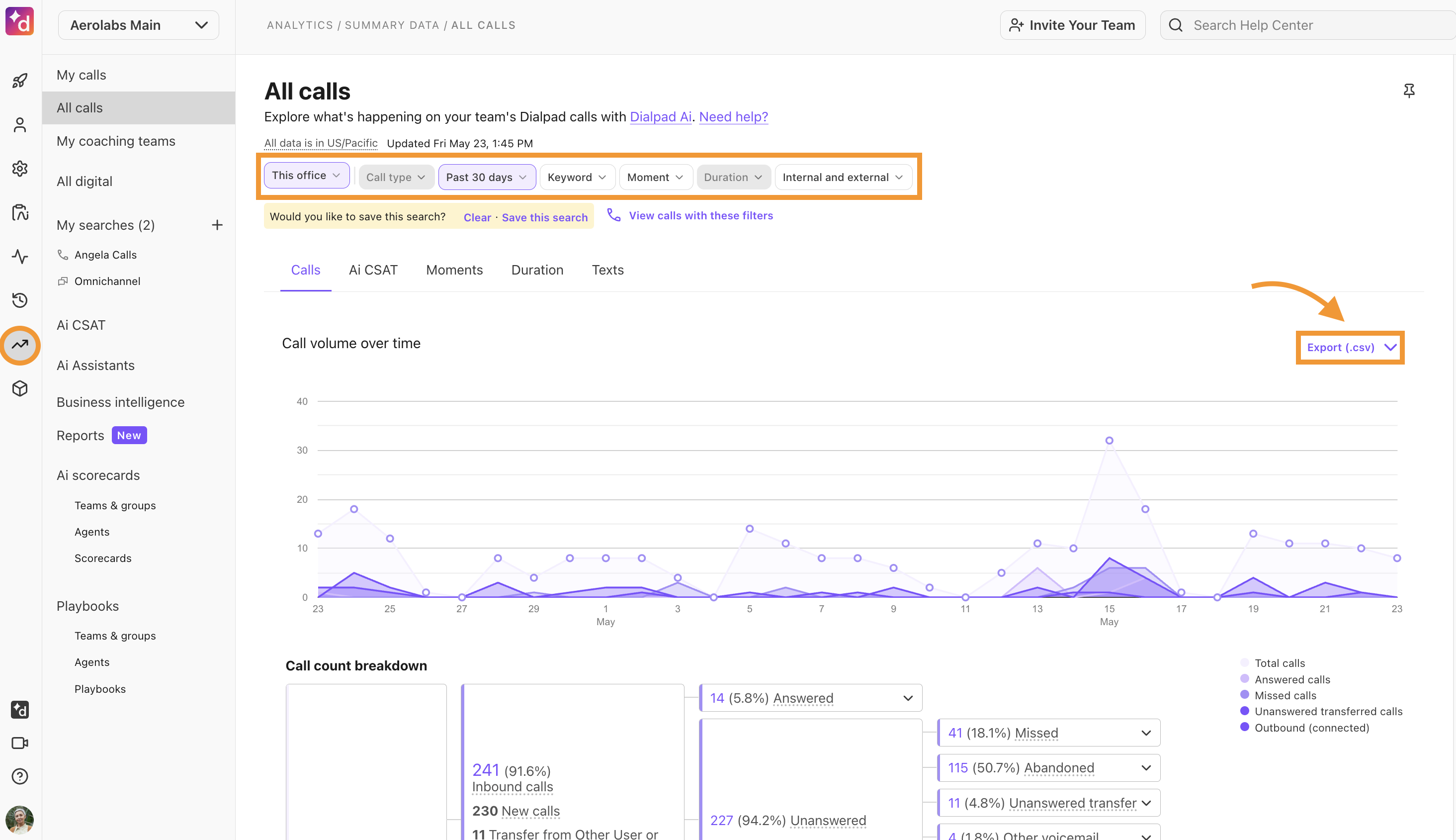Want to analyze your Dialpad data in Power BI, Snowflake, Tableau, or another BI tool? You can export Dialpad analytics using our Stats API and scheduled reports to automatically deliver CSV files to your Webhook endpoint—no manual downloads required.
Let’s dive into the details.
Who can use this
Exporting analytics data is available on all Dialpad plans.
How exporting to a BI tool works
Here’s a quick overview of how to set up automatic analytics exports from Dialpad to your BI tool:
Identify which report(s) you want to export
Create a Webhook that points to your BI tool
Create a scheduled report that points to your Webhook
Receive the reports
Import the data into your tables
Tip
Domo and Theta Lake both have direct connectors to simplify this process.
Set up Analytics reports
Choose a report
Your Dialpad analytics data can be exported in CSV format from the Dialpad Admin Portal.
Select Analytics
Set the desired filters
Select Export (.csv)

Choose the desired report
All downloadable reports from the Admin Portal are also available via API.
Tip
Be sure to read these Help Center articles:
Understand key call identifiers
When working with exported call data, it's important to understand how to join tables and interpret call relationships.
.png)
call_id | A unique ID for each call leg. |
entry_point_call_id | Ties related call legs together when a call comes through a shared line, like a Department or Contact Center. |
entry_point_target_id | ID of the original Department, Main Line, or Contact Center. |
Fanout calls | Created for each time an Operator or Contact Center agent is “rung” in a Department or Contact Center. These are given unique call ID’s in our platform, but can be mapped to the parent call by using entry_point_call_id or entry_point_target_id. |
master_call_id | Groups transferred calls under one umbrella. Only generated when calls are transferred between Dialpad endpoints.
|
For more details about how calls flow through the system, see the Call Events - Call Flow Structure article.
Set up a Webhook
To receive scheduled reports, you’ll need a Webhook that can accept POST requests.
For more information about webhooks, see the Event Subscriptions Webhook article.
Create a scheduled report via API
Use the Stats API to set up recurring reports. Key fields include:
report_type | Matches the report from the Analytics dashboard. |
frequency | Daily, weekly, or monthly. |
destination | Your Webhook URL. |
Note
You can point multiple scheduled reports to the same Webhook.
Receive and download the file
When the report is triggered, your Webhook will receive a payload containing a file_url and filename. Use your API token or OAuth credentials to download the CSV and load it into your database.
Tip
If you don’t want to set up scheduled reports, use the GET endpoint to pull data as needed. This will return a one-time file URL you can download.
For more information, read these articles:
Exporting SMS content
If your report includes text messages, use export_type=records and stat_type=texts. Make sure the message_content_export:all scope is included in your OAuth token as well.
Note
Additional configuration may be needed in your Dialpad account.
For more information, see the SMS Traffic Export article.
Exporting call transcripts
Call transcripts aren't included in stats exports and must be pulled individually using the call_id.
Use this API: Get Call Transcript. For more information, see the Call Transcript -- Get article.
Note
You cannot use master_call_id to retrieve transcripts.
Accessing Ai data from calls
Dialpad Ai features like summaries, action items, and playbooks aren’t included in scheduled or on-demand reports. To capture these in real time, subscribe to event streams for:
recap_action_items
recap_outcome
recap_purposes
recap_summary
ai_playbook (for Dialpad Sell and Support)

Note
Ai events require transcription to be turned on during the call.
Call Recording Exports
You can pull call recordings in a couple of ways:
Per Call | For more details, see the Call -- Get article. |
Via a Scheduled Report | For more details, see the schedule reports -- Create article. Make sure to include "report_type": "recordings". |
Tip
We recommend using the scheduled report to grab calls for larger groups. Since you can’t export for the whole company, you will need to export for each Dialpad Office.
The exported report includes a URL that requires authentication to access the file. All recording links start with “https://dialpad.com/secureblob/callrecording/” and require OAUTH or an API key with the “recordings” scope.
For more details, see the Review the Recordings Export article.
Authentication tips
While you can use an API Key for initial testing, we recommend using OAuth for production environments.
Scopes you may need:
recordings_export | For audio file URLs. |
message_content_export | For SMS exports. |
message_content_export:all | For company-wide message exports. |
Tip
Review these articles before proceeding:
Frequently asked questions
Can I use the same Webhook for multiple reports?
Yes. You can configure several scheduled reports to send to the same Webhook URL.
What happens if my Webhook is down?
The delivery may fail. Make sure your Webhook has retry logic or monitoring in place.
Can I export call transcripts in bulk?
Not currently. Each transcript must be retrieved individually using its call_id.
How often can I schedule reports?
Reports can be scheduled daily, weekly, or monthly. The frequency is set in the frequency field of the API request.
Are Ai Summaries included in scheduled reports?
No. AI elements must be collected via event subscriptions.